By Sean Fagan
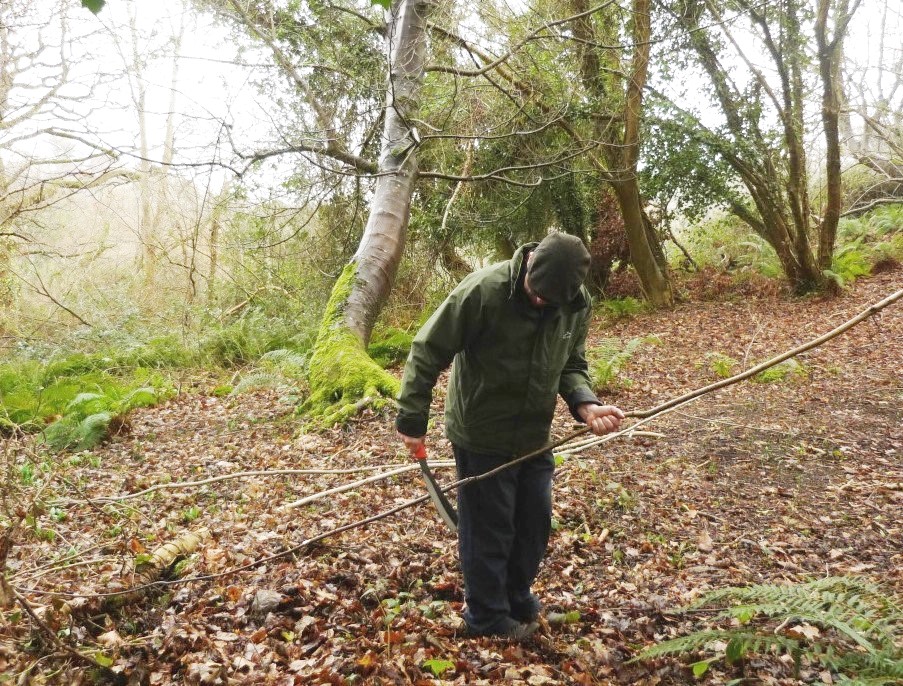
Limbing a hazel branch with a parang, Ireland. Limbing is simply the process of removing side branches from a main branch and is mostly done with either an axe or parang/machete. It can be done with a knife but requires more effort (Photo: Sean Fagan).
.
.
About 6 months ago I bought my first parang.
Parangs, like machetes, are one of the main cutting tools for rainforests.
The axe may be considered the king of sharp-edged tools for bushcrafters in the coniferous woods of the north - while the saw and knife comes into its own in temperate woodlands…but the greater reality is that all three of these tools can be used effectively in both types of woodlands.
Not only can they be used on their own to great effect - but when used together they are a powerful, versatile trio.
So many bushcraft projects can be fashioned with these three tools – from a spoon to a log cabin. They are amazing, enabling tools when used effectively and safely.
But when it comes to the densely-vegetated, tropical rainforests a more specialised tool is often required…
.
The Long Blades of the Jungle
Bushcraft in tropical rainforests often requires a long-bladed tool such as parangs and machetes.
This is partly because a long-bladed tool is required to chop a trail through the dense, jungle vegetation.
.
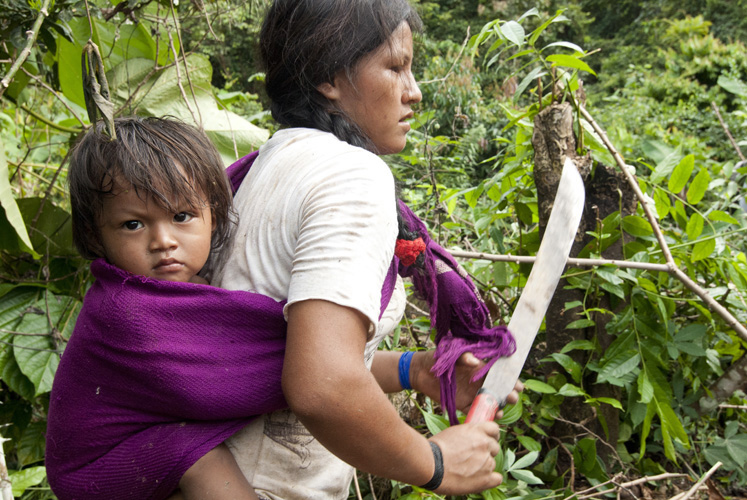
Machetes and parangs are still commonly used in the remaining tropical rain-forests of the world (Photo: Wikimedia commons).
.
Without a parang (or its equivalent) it can be extremely difficult to even hike to your destination.
I've walked through many coniferous and deciduous woodlands and I've very rarely been completely closed off by dense vegetation. Usually I can walk around dense vegetation.
The worst I've ever experienced was in Canada when a broad section of a valley slope was obscured by large, storm-felled trees - which greatly slowed down my hiking speed. In general though - my passage through deciduous and coniferous woodland has been mostly unimpeded.
But in a tropical rain-forest it can different - the vegetation often closely surrounds the traveller - often to a claustrophobic degree. Being able to chop a trail through such vegetation is often essential, especially considering there are many thorny plant species in rain-forests.
.
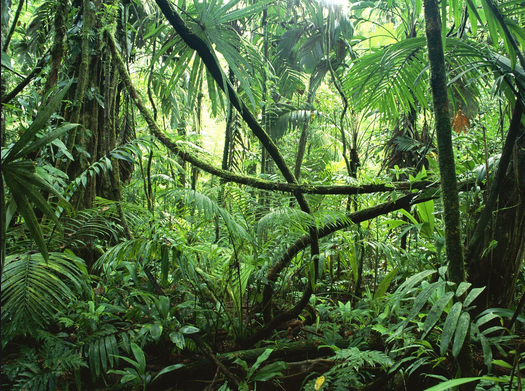
Rain-forests are often dense with woodland floor vegetation. The high rainfall and high temperatures along with the incredible biodiversity helps create optimal growing conditions for wild plants (Photo: Wikimedia commons).
.
A Brief History of the Parang
.
Parangs are interesting.
I’m not the only one that likes them – famous survival instructors: John Wiseman and Ray Mears both highly recommend the parang for jungle bushcraft.
Parangs hail from the Malay archipelago – a vast, oceanic, tropical region situated between the Indian and Pacific oceans - which has, incredibly, over 25,000 islands (including island nations such as Brunei, Singapore, East Malaysia, Indonesia, the Philippines and East Timor). Parangs are also commonly used in southeast Asia - in countries such as Vietnam, Thailand and Cambodia.
Over the years the parang has morphed into many variants - this is partly because parangs are used across such a broad geographic area by so many people.
However the design of the parang has remained roughly the same and it's quite an ingenuous design.
.
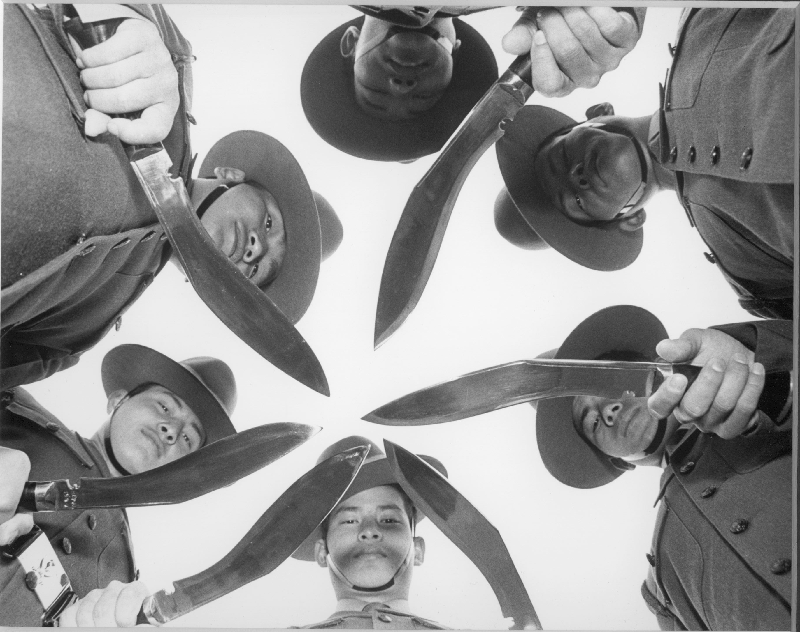
The Gurkka soldiers are mostly of Nepalese origin. They carried a parang-like weapon, a khurkuri, into battle - often to great effect. You can see in photo the basic parang design - with its distinctively curved, protruding blade (Photo: Wikimedia commons images).
.
The Parang Design
.
Not all jungles are the same - the jungles of South East Asia and the Malay archipelago are generally more woody than the jungles of elsewhere. The parang is therefore designed for a stronger chopping action - which is why the parang blade is generally on the heavy side with a more broader bevel angle to prevent binding in the wood when chopping.
.
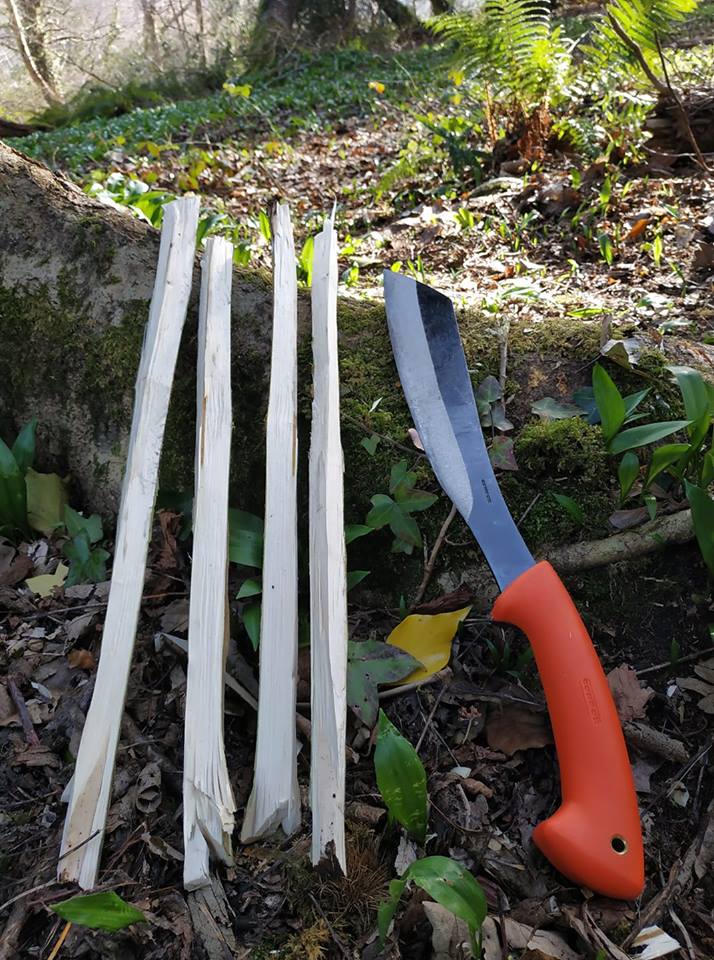
My parang is not just a heavy duty tool only suitable for coarse chopping work. It also excels as a tool that can be used for finer bushcraft tasks such as splitting wood into kindling sticks (Photo: Sean Fagan).
.
The parang has three different edges: the topmost edge is very sharp and often used for the delicate task of skinning, the middle is wider and used for chopping, and the bottom end (near the handle) is often very fine and used for carving.
Traditionally, parang handles are normally made out of wood or horn, with a wide end to prevent slippage in wet conditions.
.
My reasons for buying a Parang
.
I bought my parang for two reasons...
1) I have plans on practising bushcraft in rainforests in the near future and wanted to become reasonably competent in using one before traveling to a rainforest.
2) As a bonus of getting familiar with using a parang I wanted to find out if parangs have any real applications in the temperate, deciduous woodlands of my home country of Ireland.
I tested the performance of my parang under the following criteria:
- Felling small trees
- Limbing branches
- Chopping wood
- Splitting wood
- Debarking
- Ease of sharpening & sharp-edge retention
- Fire-lighting steel
- How it handles - its balance, weight & effectiveness
.
I also included two other tests that I had serious doubts that my parang would be effective:.
- Shaving wood
- Carving wood
My doubts about how well my parang would be able to do fine work such as shaving and carving wood is based on the robustness of my parang. My parang struck me more as a heavy-duty chopping tool rather than a fine carving tool.
Many lighter, thinner-bladed parangs are excellent for both chopping and carving/shaving wood - so keep that in mind when purchasing a parang (link for highly recommended parang that both carves and chops well here).
.
NOTE: I've included an excellent Ben Orford video on how to safely use a parang at the end of this blog (or skip to video here).
.
Tree FellingThe parang works very well for felling small trees. The long length of the blade and heaviness of the parang along with the broad bevel angle really helped. Of course if you can fell a small tree you should be able to fell a large tree with the same tool. However, a long handled axe would be far more efficient (and kinder to your back) than a parang, mostly because of the much longer reach of an axe - which imparts a greater amount of force with less effort. Still, it's good to know that a parang can take down a tree when needs be.
.
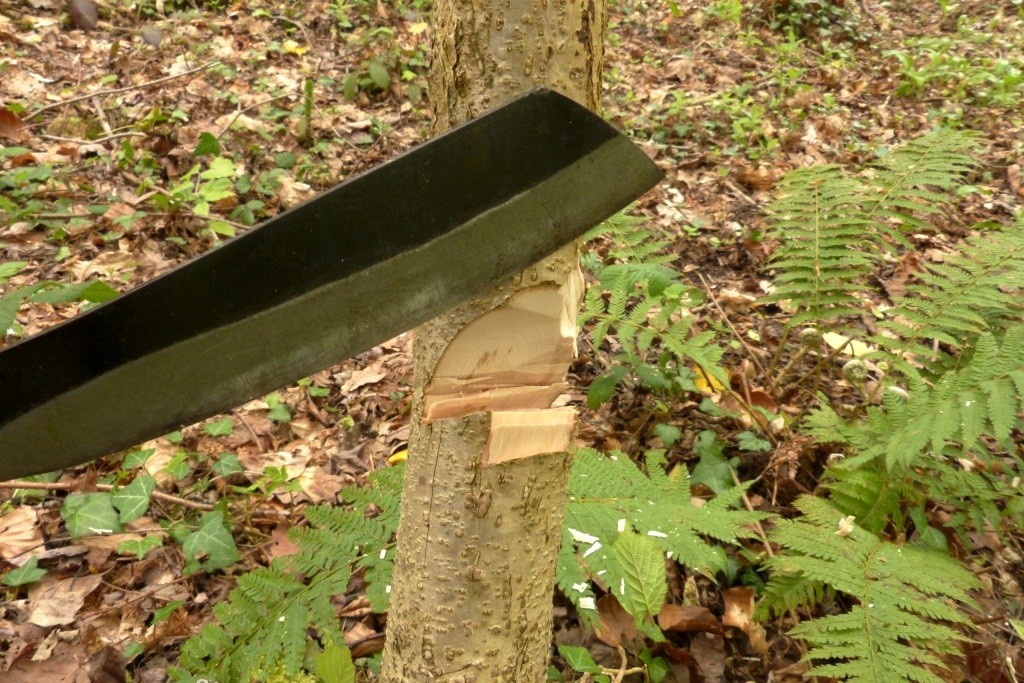
The parang excels as a chopping tool. The small tree in photo was felled in a few minutes - just as quick as an axe (Photo: Sean Fagan).
.
Limbing branchesThe parang excels in limbing branches. Worked as good if not better than my axes and hatchet. It's very easy to just place the parang blade along the main branch and forcefully slide forward to remove side branches.
.
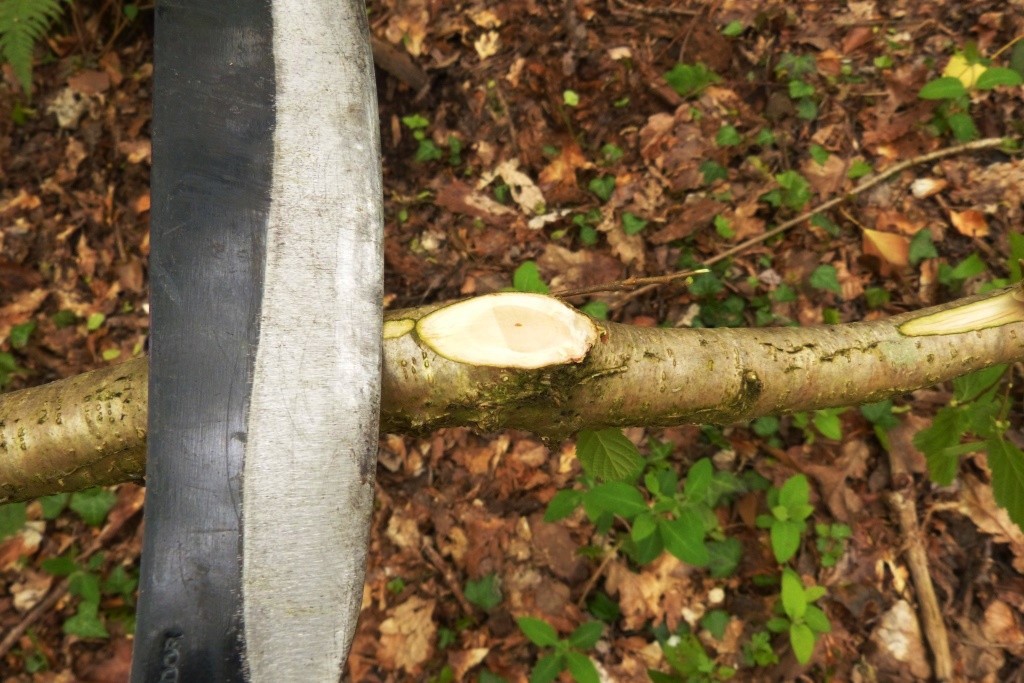
The parang is excellent for limbing branches - often, all that is required is placing the blade along the main branch and forcefully sliding the parang along the branch to cut off side branches (Photo: Sean Fagan).
.
Chopping wood Works well, no complaints. As good as a hatchet or small axe..
Splitting wood into Fine Lengths for KindlingSurprisingly good - used a form of splitting called contact splitting.
.
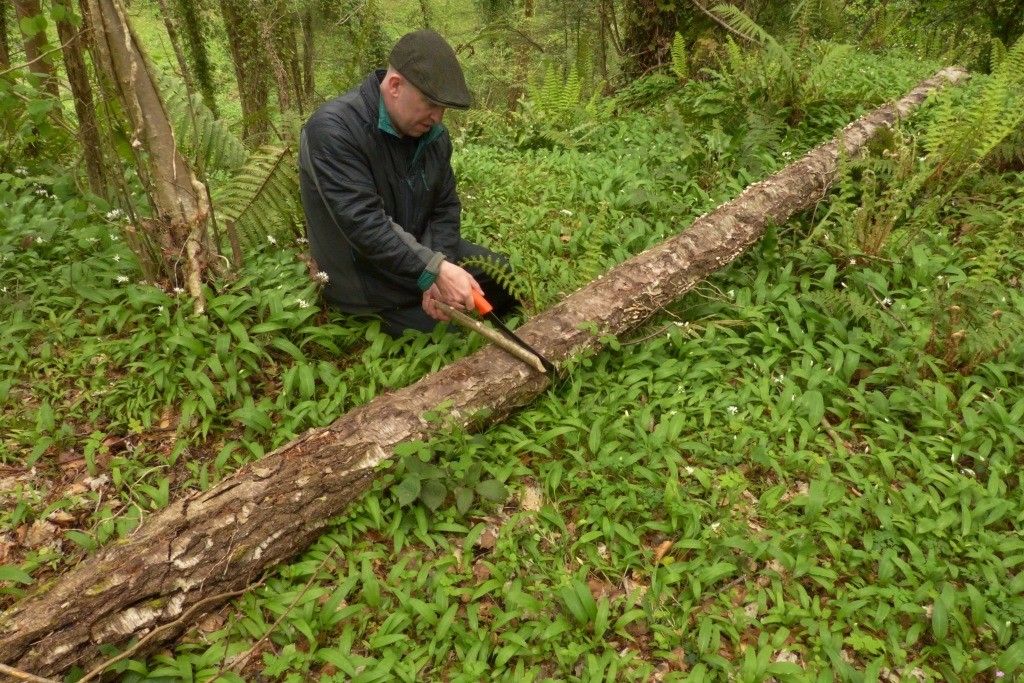
With a parang (or an axe) the safest way to split wood is through contact splitting. Place blade edge along middle line of wood to be split. Lift both parang and wood then drop, with controlled force, the parang and wood onto a hard surface. The parang will split the wood. A fallen tree is ideal as a hard surface for splitting, as in photo (Photo: Sean Fagan).
.
DebarkingDebarking wood is often important with bushcraft projects such as processing pliable tree bark for making string or rope. The outermost layer of the bark is often removed to improve the flexibility and strength of the bark. In Ireland, some of the tree barks for making rope are lime, willow, elm and sweet chestnut. In the rain-forests of the world there are many trees that yield pliable tree bark.
My parang worked fine for debarking trees. All that is really required for debarking is a straight, hard edge and this edge can be found on the back of my parang blade. By simply running the edge along the tree bark the outermost bark is scraped off.
Ease of sharpening & sharp-edge retentionExcellent - sharpens well. I used a sharpening puck to obtain a sharp edge. The sharpened edge retained its sharpness for a long time, surprisingly long, considering the amount of heavy chopping I was doing.
Fire-lighting steelProduced plenty of hot, large sparks from my fire-steel. Hardly surprising considering the blade is made from high carbon steel. High carbon steel works well with fire-steels for producing sparks.
How it handlesMy particular parang is a little on the heavy side. It's a tool more geared towards chopping, which made it a surprisingly effective tool when used on the hardwoods of Ireland. I was more than impressed.
The key with chopping with a parang is to make contact with the most forward point of the blade. Where the blade protrudes furthest. When you consistently use this sweet spot when chopping - it makes a significant difference in the transfer of power in your chopping action.
Carving & Shaving Wood
This is where my parang faltered a lot in its performance. Simply put - the blade is too broadly beveled and badly designed for carving and shaving wood. A parang with a thinner bevel at its base (near the handle) is desirable for fine carving and shaving. Not only is the bevel of my parang too wide but the blade does not fully extend down to the handle. The majority of carving with a parang is done near the handle so as to retain maximum control of the blade - essential for fine, detailed carving.
However, after all that - I will be doing some extra sharpening of the parang blade at the base to see if it can carve well. I will also make an extra effort to lessen the parang bevel at the base to improve its carving ability.
.
REMINDER: at the end of this blog is a brief Ben Orford video on how to safely use a parang. Highly recommended.
.
.
.
Related articles on this website:.
A great parang tutorial by Ben Orford:
Recent Comments